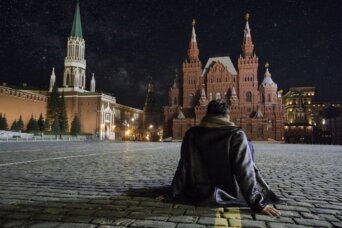- About
- Topics
- Picks
- Audio
- Story
- In-Depth
- Opinion
- News
- Donate
-
Signup for our newsletterOur Editors' Best Picks.Send
Read, Debate: Engage.
| topic: | Racism |
|---|---|
| located: | Russia |
| editor: | Igor Serebryany |
The coronavirus pandemic decreased the number of inter-ethnic and inter-confessional conflicts in Russia but cases of anti-migrant and other xenophobic manifestations moved online, said an annual report published by the Moscow Human Rights Bureau (MHRB) this week.
The report covers the period from January to October. According to the paper, the tension between different ethnic and religious groups eased following the introduction of social distancing measures, which allow limited physical contact between people, (this might be the only bright side of the pandemic in Russia).
The trend could continue in the coming months as no easing of the counter-coronavirus restrictions in the country has been foreseen at least until February 2021. In May, ultra-right groups called off their traditional 'Russian May' march. On November 4, Russia's official Day of National Unity which has been hijacked by ultra-nationalistic groups in previous years, no mass rallies were held.
In February in St-Petersburg, a migrant worker from Central Asia was attacked. In May, also in St-Petersburg, a group of youngsters attacked an African in the subway. In June, a 22-year-old man stubbed to death an Azeri national. Several times this year unidentified people vandalised monuments with Nazi symbols. Since the start of 2020, no other organised or spontaneous anti-migrant actions have been reported.
Authorities in Moscow and St-Petersburg, where xenophobic sentiments are the strongest due to the high percentage of the migrant population, ban all public gathering this year citing a coronavirus threat. Tension fell also because the number of guest workers visibly shrank after Russia closed its borders and migrants returned to their countries of origin. The official data show that in October, the migrant population in Moscow decreased by 40 per cent compared to January.
On the flip side, as all public activity has increasingly been moving online due to the pandemic, cases of xenophobia grow on the web as well.
"Hatred on the internet keeps growing, it targets the remaining migrants who are stuck in Russia for various reasons. Meanwhile, the Russian economy is starting to experience a shortage of human resources, as about a million and a half of foreign workers have left the country this year alone," head of the MHRB Alexander Brod says.
Still, the situation can be described as a temporary lull enforced by non-related outside causes (the pandemic) rather than the sustainable dissolution of the ethnic tension, he adds.
Most often, posts on social media call to introduce visas for the nationals of the former Soviet republics. Hate speech online mostly, and traditionally, targets Romas, Chechens and other North Caucasus ethnic groups (who are the citizens of the Russian Federation) and people of non-white origins, such as Chinese and Africans (who are not).
This year, human rights groups received nearly 50 thousand complaints from foreign nationals, a significant growth compared to last year's 36,000, director of the international NGO Tong Jahoni, Valentina Chupik, says.
"Migrants complained about refusals to issue papers by the authorities, illegal police raids and home searches, denying of medical aid. Over 600 migrants complained that the ambulances refused to attend to emergency calls after learning the callers were migrants," she says.
Generally, xenophobic sentiments in Russia remain relatively moderate in 2019 and 2020, director of the Sova analytical centre Alexander Verkhovsky confirms.
"In spring, Russian society was seriously concerned that the migrants who had lost their jobs and were unable to leave the country could form criminal gangs. That anticipation caused a hike of anti-migrant sentiments. But since no crime rate grew, the ill feelings disappeared accordingly," he explains why the xenophobia in Russia stays on the fringes of society.
Moscow Human Rights Bureau sends its reports to the Federal Agency for Ethnic Affairs, Interior Ministry, Prosecutor's office and Investigative committee, Presidential Administration and the parliament.

